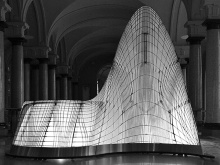Performative Morphology
ICD / ITKE Research Pavilion 2018
The focus of this studio is the design development and fabrication of a biomimetic research pavilion which will be contructed between the K1 and K2 university buildings. The pavilion will be based on design principles that have been developed Adaptive Morphology course in the WS 2017/18 semester.
Throughout history, architects and engineers have employed various technical and spatial strategies to realize adaptive structures, in which a structure might change over time to meet various performative, programmatic, or functional criteria. Technologies in fabrication, simulation, sensors and robotics offer new possibilities for adaptivity in architecture. For example, compliant mechanisms and programmed materials offer novel potential in designing shape change, and embedded robotic mechanisms expand possibilities for actuation and reconfiguration. Additionally, embedded sensing and inter-device communication can enable structures to understand and respond in real time to current conditions.
By hybridizing and recombining machinic and robotic mechanisms with pre-programmed and compliant materials, a new space of possibilities emerges for distributed, actuated, and responsive material systems and architecture. The goal for this studio will be to develop a deployable component-based composite system which utilises simple compliant mechanisms and robotic actuation to alter its geometrical or topological configuration locally or globally towards a performative goal or state. For example: to respond to user feedback or data, to augment the construction process, or to seek structural equilibrium. The design and development of this adaptive system will necessitate simulation, materialization, assembly and actuation methodologies. Additionally, the studio will investigate conceptual questions relating to adaptivity and agency, considering why structures need to adapt and what it means for architecture, engineering, and the built environment.


